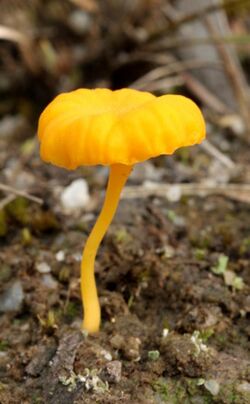Biology:Lichenomphalia chromacea
| Lichenomphalia chromacea | |
|---|---|

| |
| Scientific classification | |
| Domain: | Eukaryota |
| Kingdom: | Fungi |
| Division: | Basidiomycota |
| Class: | Agaricomycetes |
| Order: | Agaricales |
| Family: | Hygrophoraceae |
| Genus: | Lichenomphalia |
| Species: | L. chromacea
|
| Binomial name | |
| Lichenomphalia chromacea (Cleland) Redhead, Lutzoni, Moncalvo & Vilgalys (2002)
| |
| Synonyms[1] | |
| |
Lichenomphalia chromacea is a species of basidiolichen in the family Hygrophoraceae. It is found in southern Australia. The yellow-orange fruiting bodies of the species are mushroom-like, with a cap width of typically less than 4 cm (1 1⁄2 in). The thallus of the lichen is a greenish, granular layer of fungal hyphae and algae on the soil around the base of the stipe.
Taxonomy
The species was first scientifically described as a new species by John Burton Cleland, based on specimens collected from South Australia.[2] In 1978, Scott Redhead and Thomas Kuyper transferred it to the genus Botrydina,[3] and a year later—following changes to the rules for botanical nomenclature—to Phytoconis.[4] Both of these genera have since been synonymized with Lichenomphalia. Tom May and Alec Wood proposed it be classified in Omphalina in 1995.[5] In 2002, the basidiolichen genus Lichenomphalia was circumscribed, and this species was one of several that were transferred to it.[6]
Description
Lichenomphalia chromacea produces yellow to orange mushroom-like fruiting bodies, with a cap diameter between 9 and 38 mm (0.4 and 1.5 in), and a shape that is initially convex and umbilicate, later becoming flattened, but still umbilicate. The thick gills on the underside of the cap are distantly spaced, usually with a decurrent attachment to the stipe, which itself is slender and cylindrical, measuring 19–51 mm (0.7–2.0 in) long. The basidia are usually four-spored, but very rarely they are two-spored. The basidiospores are hyaline, ellipsoid, and measure 6.4–10.4 by 3.4–6.2 μm.[7] The thallus of the lichen is disc-shaped to angular, measuring 200–900 μm broad and forming a green, crust-like surface when crowded together.[3]
Habitat and distribution
Lichenomphalia chromacea occurs in South Australia, New South Wales, and Tasmania. It fruits in clusters on the ground, or occasionally on bark, and often amongst mosses.[7] In Tasmania, it is typically encountered in sandy or peaty soil in heathland and woodland, and usually at higher elevations. The only other members of genus Lichenomphalia that occur in Australia are L. tasmanica and L. umbellifera.[8]
References
- ↑ "GSD Species Synonymy: Lichenomphalia chromacea (Cleland) Redhead, Lutzoni, Moncalvo & Vilgalys, Mycotaxon 83: 37 (2002)". Species Fungorum. http://www.speciesfungorum.org/GSD/GSDspecies.asp?RecordID=375176.
- ↑ Cleland, J. Burton (1924). "Australian fungi: notes and descriptions. - No. 5". Transactions and Proceedings of the Royal Society of South Australia 48: 236–252. https://www.biodiversitylibrary.org/page/41571575.
- ↑ 3.0 3.1 Redhead, S.A.; Kuyper, Th.W. (1987). "Lichenized agarics: taxonomic and nomenclatural riddles". Arctic and Alpine Mycology 2: 319–348. doi:10.1007/978-1-4757-1939-0_21. ISBN 978-1-4757-1941-3. https://www.researchgate.net/publication/40174583.
- ↑ Redhead, S.A.; Kuyper, T.W. (1988). "Phytoconis, the correct generic name for the basidiolichen Botrydina". Mycotaxon 31 (1): 221–223. http://www.cybertruffle.org.uk/cyberliber/59575/0031/001/0221.htm.
- ↑ May, Tom W.; Wood, Alec E. (1995). "Nomenclatural notes on Australian macrofungi". Mycotaxon 54: 147–150. http://www.cybertruffle.org.uk/cyberliber/59575/0054/0147.htm.
- ↑ Redhead, S.A.; Lutzoni, F.; Moncalvo, J.M.; Vilgalys, R. (2002). "Phylogeny of agarics: partial systematics solutions for core omphalinoid genera in the Agaricales (euagarics)". Mycotaxon 83: 19–57. http://www.cybertruffle.org.uk/cyberliber/59575/0083/0019.htm.
- ↑ 7.0 7.1 Grgurinovic, C.A. (1997). Larger Fungi of South Australia. Adelaide: State Herbarium of South Australia. pp. 314–315. ISBN 978-0-7308-0737-7.
- ↑ Kantvilas, G.; Jarman, S.J. (2012). "A new lichenised basidiomycete from Tasmania". Kanunnah 5: 106–112. https://www.researchgate.net/publication/277013212.
Wikidata ☰ Q10561220 entry
 |

